Exploring key generosity trends to amplify social good in 2023

2022 was a year of perseverance in the ever-evolving social good sector. Nonprofit organizations and companies leading corporate social responsibility (CSR) initiatives navigated economic uncertainties, natural disasters, and social and political injustices while staying true to their mission to serve the growing communities. And with a purpose to power those who power social impact, Bonterra’s best-in-class program management, CSR, supporter engagement, and donor engagement solutions provided the technology required to support our customer’s critical efforts.
In 2022, over $6.7 billion was raised through individual giving and employee matching programs across Bonterra’s CSR and Fundraising and Engagement solutions. Our CSR customers also awarded over $6 billion in grants this past year. These contributions fueled the operations and services of over 341,000 organizations in the United States, 23% of the estimated 1.5 million nonprofits registered in the country, according to the National Center for Charitable Statistics (NCCS).
In this blog, we will delve into key metrics and findings collected throughout the year and within the 2022 year-end giving season that drive current generosity trends within the social good sector, and the following four insights you can act on in 2023:
- Donors that give for the first time during year-end are more easily retained
- GivingTuesday-level engagement is being replicated outside of year-end
- Newer employees are increasingly participating in giving programs
- World events affect which causes people give to throughout the year
Current generosity trends within the social good sector
Over the past several years, Bonterra and other leaders in the social good space have observed that nonprofits continue to raise more dollars overall but are experiencing a decline in the number of individual supporters giving to their causes. The results from Fundraising Effectiveness Project’s Q3 2022 report published in January 2023 backs this up, noting that although donations have increased by 4.7% year to date (YTD), the number of individual donors has decreased by 7.1%. There are many complex factors contributing to this decline in donor numbers, including the widening wealth gap and the rising cost of acquiring and retaining donors.
Data also shows that organizations receiving funds from donors of all sizes, including the smallest gifts are more resilient and able to adapt to change more effectively than those that only rely on large donors who are commonly one of the first groups to tighten their purse strings when it comes to engaging in philanthropic activities during times of economic uncertainty. By ensuring their message is reached by and resonates with a large audience of supporters with diverse backgrounds throughout the year, organizations are better prepared for fluctuations in giving and have better process in place to engage and retain a diverse set of new donors. And there are many opportunities for companies implementing employee giving programs to help connect their diverse workforce with these impactful causes both through monetary support and acts of kindness.
Lastly, the year-end giving season, defined by Bonterra as Nov. 15 to Dec. 31, continues to be an opportunity for nonprofits and companies with CSR strategies to combat these industry-wide donor trends. With GivingTuesday and New Year’s Eve regarded as the two largest days of giving, the last six weeks of the year are crucial for the social good sector in bringing a resurgence of new and returning supporters of all sizes.
Data collected across Bonterra’s CSR and fundraising solutions highlight the influx of giving that takes place during the year-end season, especially when compared to the full year.
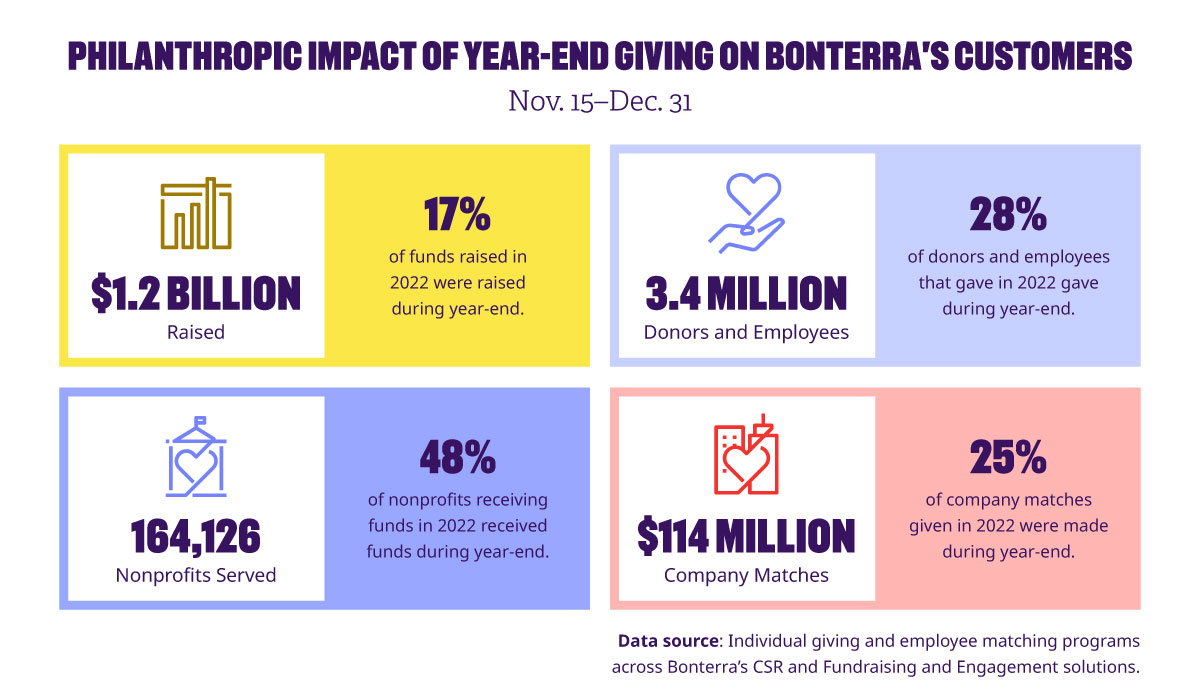
Key insights to act on in 2023
Bonterra has leveraged its unique ability to collect insights from nonprofits and companies of all sizes to gain a full understanding of the trends and behaviors of the complete philanthropic landscape. Below are four key insights to act on in 2023.
1. Donors and employees that give for the first time during year-end are more easily retained
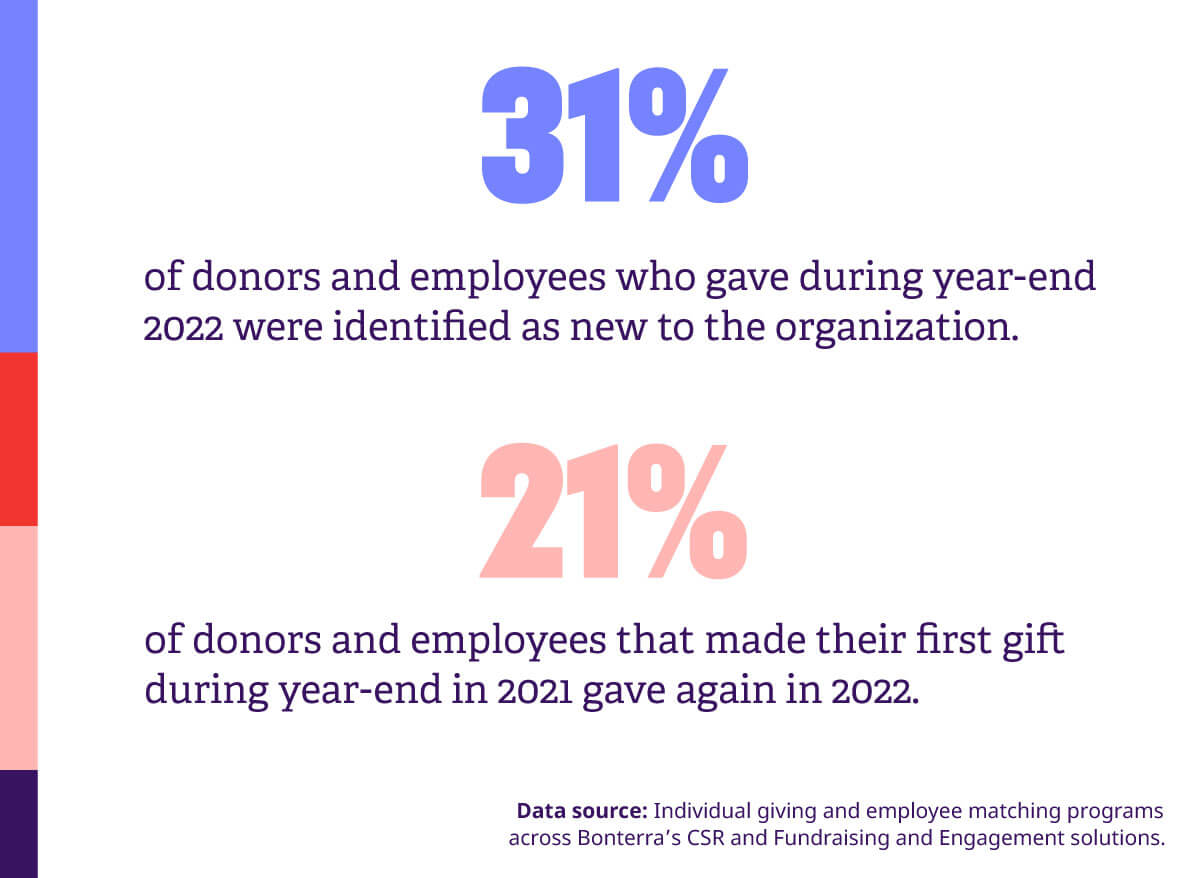
Year-end giving season is a unique time of the year when individuals are actively seeking out causes to support. And while some may assume that these new donors are just making a one-time gift because of a request from their peers or employers on GivingTuesday or to maximize their tax credits, we are uncovering that it is quite the opposite!
People participating in the year-end giving season are encouraged to spend time researching and vetting where they want to give their time and dollars. In doing so, they are finding causes that resonate with their values and discovering ways to amplify their contributions through matching programs. And because these new supporters can establish a deeper understanding of the organization’s mission and make a greater impact from the start, we are seeing that they are more likely to give again. Nearly a quarter of donors who gave through Bonterra’s CSR and Fundraising and Engagement solutions during year-end 2021 made an additional gift in 2022, including those who gave through employee giving initiatives. The Association of Fundraising Professionals (AFP) backs up these findings, noting that donors who give on New Year’s Eve have a 15% higher lifetime value than the average donor.
Take Action
Nonprofits: While it may seem unnatural to make a second request so soon after a donor’s first gift, now is the perfect time to do so. Additional data from AFP shows that 10% of year-end donors made a second gift within two months of their first! These new year-end donors are eager to discover more ways to support your cause, even if they are unable to make an additional gift right away. Fostering these new relationships early on will go a long way toward converting them into long-term supporters.
Corporations: Instituting CSR programs is an incredible benefit for your company as it highlights your commitment to serving your community’s needs. They also provide authentic opportunities to engage and connect with your workforce. This is something that has been increasingly important as employers begin to recruit and retain incoming Gen Z employees, which hold a higher value on their workplace’s commitment to social good. Make sure you are communicating these benefits with your employees year-round, so it stays top of mind for them to take full advantage of this program and encourages them to continue supporting and engaging with the new causes they discovered during year-end.
2. GivingTuesday-level engagement is being replicated outside of year-end
The surge of new and returning support that comes in during year-end has become increasingly important. Waiting until next year-end for another influx of giving limits a nonprofit’s capacity and decreases participation in employee giving programs. At Bonterra, we have found that organizations and companies that lean into developing giving moments that incite similar excitement and engagement as GivingTuesday throughout the year observe similar results!
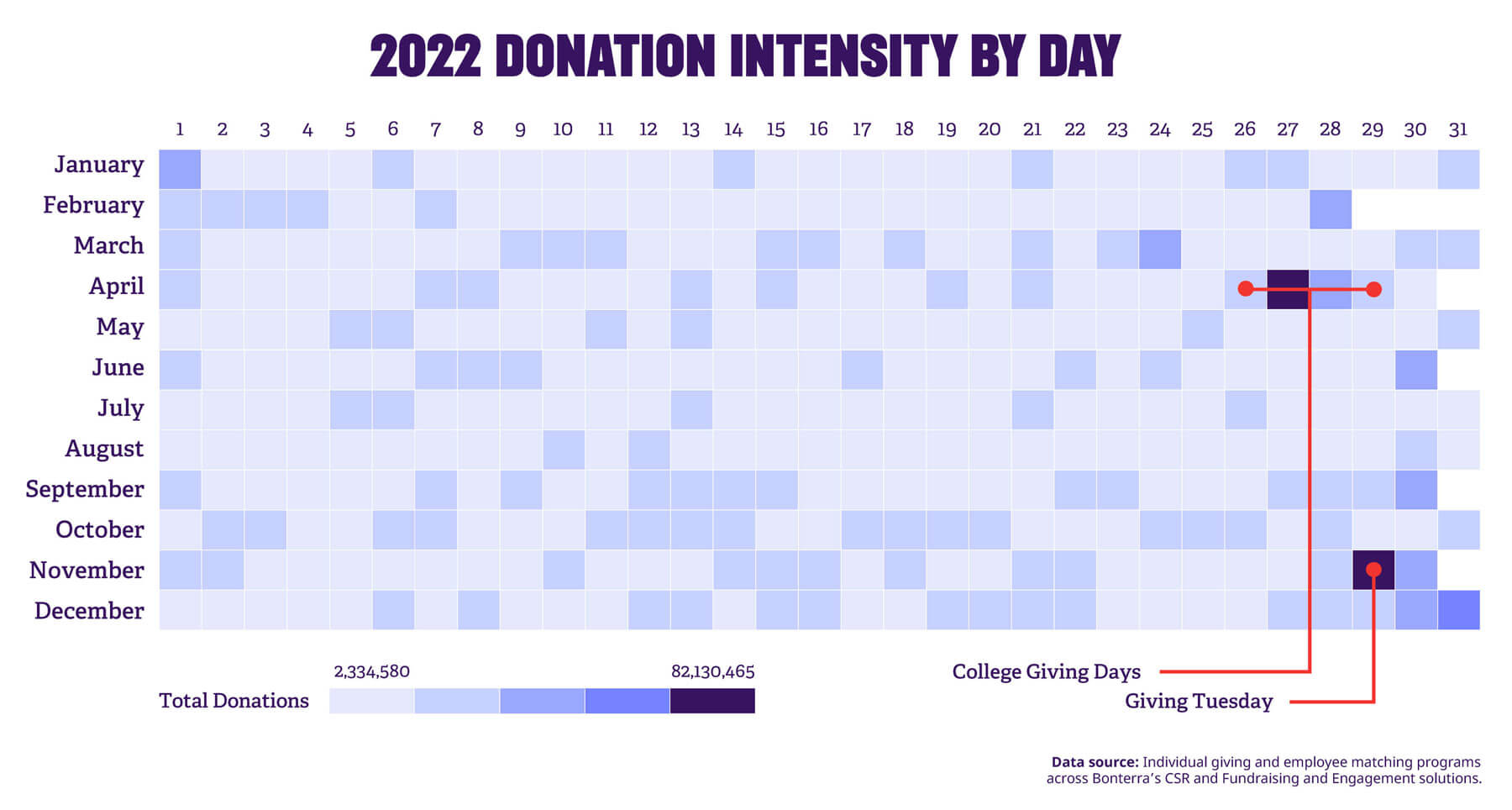
The chart above showcases the amount of giving that took place each day of the year through Bonterra’s CSR and Fundraising and Engagement solutions. You can see an increase of darker boxes toward the end of November and into December, indicating the heightened donation frequency during GivingTuesday and the entirety of year-end.
We also want to point out the set of dark boxes that appear near the end of April. These boxes indicate a popular time of fundraising for a subset of colleges that host Giving Days. These 24-hour digital events inspire philanthropy and acts of service within an organization, campus, company, or community. Giving events, such as Giving Days, have been proven to capture a wide base of supporters by using the same tactics as GivingTuesday, such as matches, time-sensitive incentives, and an increase in promotions through the media and grassroots efforts. And there’s ample evidence that shows that organizations that leverage their own giving events, in addition to participating in GivingTuesday and year-end, have a steadier flow of support reaching their causes throughout the year!
Take Action
Corporations and Nonprofits: Consider how your nonprofit or company can create its own digital giving event, such as a volunteer drive, a week-long giving challenge, or a Giving Day. Pick a date that will resonate with your donors or employees, such as National Nonprofit Day, and develop ways you can generate community-wide engagement through fun incentives, matching offers, and acts of service. GivingTuesday creates a sense of excitement and engagement around philanthropy that can be replicated at your organization or company any day of the year!
3. Newer employees are increasingly participating in giving programs
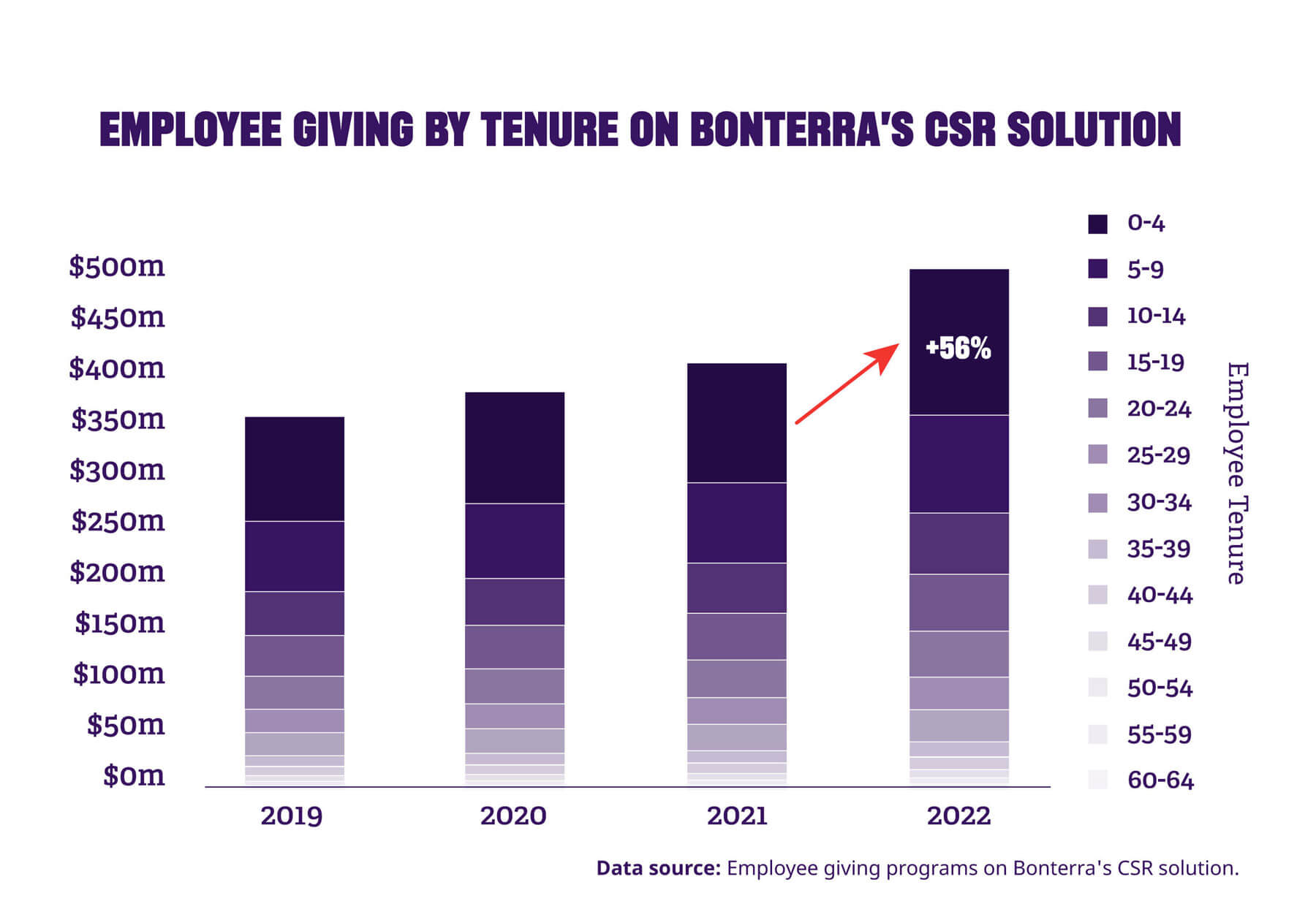
When reviewing year-over-year data within Bonterra’s CSR solution, we saw a substantial increase in new employees participating in giving programs. In 2022, employees with less than five years of tenure made up the majority, or 20%, of all giving taking place. And what is even more notable is that employees who have been around for only two years accounted for 10% of their company’s giving! Giving by first-year employees also doubled in 2022 when compared to 2021.
These are exciting trends that signify the importance of creating a culture of philanthropy and giving early on in an employee’s tenure. As nonprofits continue to see declines in donor counts, it has become increasingly important that workplaces with giving programs not only continue to inspire acts of giving in new employees, but that companies also foster their passions for the duration of their time with the company.
Take Action
Corporations: Consider creating additional incentives to encourage volunteering and employee giving among new hires and find creative ways to acknowledge staff with longer tenures who have continued to use your program to make recurring contributions to the causes they love. Companies utilizing CSR technology can create initiatives that provide a lower barrier for entry for employees looking to make an impact in their community, including dollars for doers and other volunteer programs. And as these employees continue to participate in these programs, it will become easier to encourage them to contribute to additional efforts as they grow within the company.
Nonprofits: Include a note in every ask requesting that the donor checks with their employer to see if they have instated a giving program that will maximize their contributions. Even if a donor is a longtime supporter of your organization, they could be a new employee of a company that runs a giving program. This reminder will encourage donors to take full advantage of this benefit and allow them to increase their impact on your mission. If a donor shares with you that their employer does not have a giving program, encourage them to ask their company if they would be willing to create one to develop a larger base of support within the community!
4. World events affect which causes people give to throughout the year
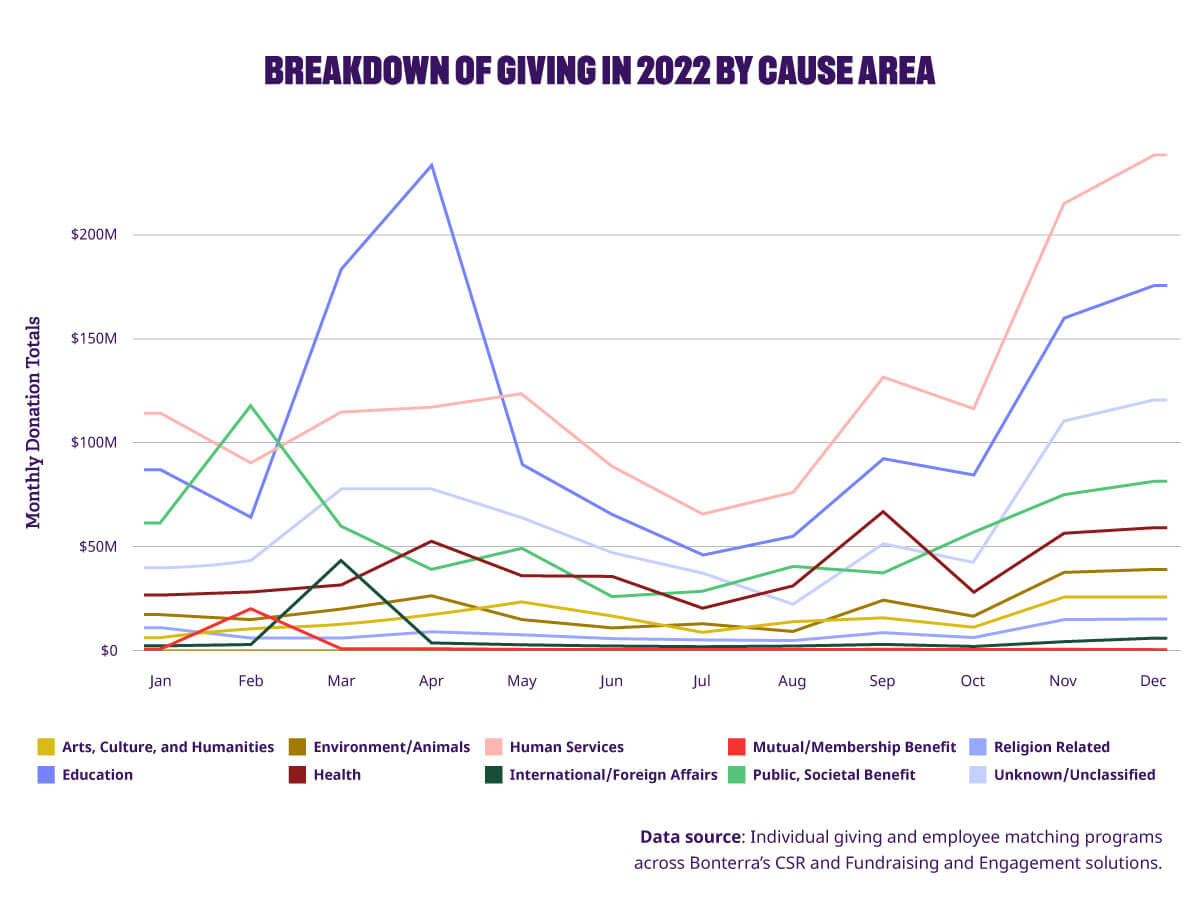
In 2022, the world experienced a multitude of significant economic, political, and social events that directly affected how donors gave throughout the year. By understanding how outside trends impacted the social good sector, we can gain a better insight into what may have influenced our giving efforts results in 2022.
- In March, giving to International and Foreign Affairs causes peaked in direct response to the crisis in Ukraine.
- In April, giving to Education causes grew in response to the college Giving Day season.
- In June and September, giving increased to Human Services and Health causes in correlation with the overturn of Roe v. Wade and Hurricane Ian.
The cause category that received the largest amount of support in 2022 was Human Services, followed by Education, Health, Environment and Animals, and Public Societal Benefit.
And most notably, during the year-end season, we see an increase in giving for all cause types. This indicates that while giving is influenced by world events and trends, donors use year-end as a time to contribute to causes that most impact their personal values.
Take Action
Nonprofits: There are many factors outside your control that can affect your organization’s scheduled giving campaigns. When there is a world event that has a larger impact on organizations that serve a specific cause, flexibility is required to pivot from your current efforts and focus on your communities’ immediate needs. Be proactive in finding out how your organization can use its skills and resources to further support the organizations that are most affected. For example, if you are an Arts and Culture organization, consider how you can hold a show with proceeds benefiting the relevant cause.
Corporations: While world events remain unpredictable, there are steps that your company can take to ensure you have the programs and technology in place to execute a scalable and sustainable response. With time being of the essence during these significant events, getting a new giving campaign or volunteer initiative launched as quickly as possible will allow your company to make a significant and immediate impact on alleviating growing needs. Learn more about how your company can prepare for times of heightened need here.
Looking Forward
The beginning of the new year is an exciting time for growth in the social good sector. Through data, we can lean on our past experiences and findings to develop new and creative ways to better engage and foster donor relationships and increase the participation of employees in corporate giving programs. As we move through 2023 together, Bonterra will continue to provide data-backed insights to fulfill our purpose of powering those who power social impact!
Looking for more insights into GivingTuesday and year-end? In a live session hosted on Jan. 18, 2023, Woodrow Rosenbaum, chief data officer of GivingTuesday, joined three Bonterra executives: Pete Karns, SVP of corporate strategy; Ben Miller, SVP of data science and analytics; and Kimberly O’Donnell, chief fundraising and engagement officer. The four held an extensive discussion about the impact of GivingTuesday and year-end. During this session, these leaders shared their perspectives on key insights collected across the complete philanthropic giving season lifecycle and offered data-backed strategies on how organizations and corporations can collaborate to power more social impact in 2023 and beyond.
Work with Bonterra



